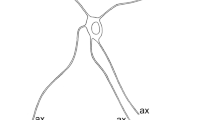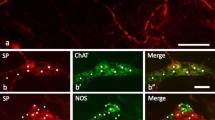Abstract.
The aim of the study was: (1) to test the suitability of neurofilament (NF) immunohistochemistry for representing the shapes of morphologically defined neuron types in the pig ileum myenteric plexus, (2) to estimate the proportions of these neuron types as related to the whole myenteric neuron population and (3) to demonstrate the usefulness of a refined morphological classification of enteric neurons on the paradigm of calcitonin gene-related peptide (CGRP)-immunoreactive neurons. So far, immunoreactivity for this peptide was supposed to be present in the pig enteric nervous system only in type II neurons. Ileal whole mounts of two pigs were stained with the cuprolinic blue (CB) method and, thereafter, incubated with an antibody pool against NF proteins (70, 160 and 210 kDa), visualised with a fluorochrome-tagged secondary antibody. The structural representation of morphologically defined myenteric neuron types typical for pig ileum (Stach I, II, IV, V and VI) was equivalent to their silver impregnated image, as demonstrated in previous studies. Counts of CB-stained neurons revealed between 2,526 and 2,662 neurons per square centimetre in one pig and between 2,027 and 2,763 in the other. As related to these total neuron numbers, the proportions of type I neurons were 1.7% and 1.5%, of type II neurons 7.2% and 7.9%, of type IV neurons 1.9% and 2.4%, of type V neurons 1.1% and 1.5%, and of type VI neurons 1.3% each. These values are generally comparable with those estimated earlier on silver impregnated material. Double labelling for NF and CGRP indicated that CGRP-immunoreactive smooth contoured neurons with long processes could be subdivided into two distinct morphological neuron types, i.e. type II and type V. We conclude that NF immunohistochemistry is an appropriate tool for representation of morphologically defined enteric neuron types in the pig. Combination of this technique with immunohistochemistry for neuroactive substances may be useful for making both morphological and chemical classification schemes mutually more precise.
Similar content being viewed by others
Author information
Authors and Affiliations
Additional information
Electronic Publication
Rights and permissions
About this article
Cite this article
Brehmer, A., Schrödl, F. & Neuhuber, W. Morphological phenotyping of enteric neurons using neurofilament immunohistochemistry renders chemical phenotyping more precise in porcine ileum. Histochem Cell Biol 117, 257–263 (2002). https://doi.org/10.1007/s00418-001-0373-z
Accepted:
Published:
Issue Date:
DOI: https://doi.org/10.1007/s00418-001-0373-z




